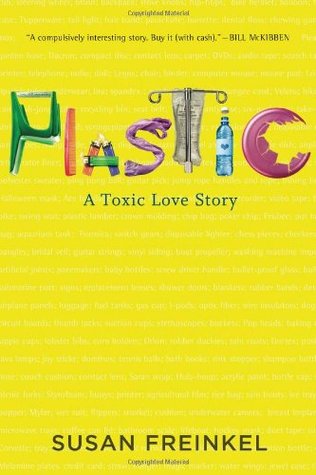Can we ever really be plastic-free???

I recently read the book “Plastic: A Toxic Love Story” by Susan Frienkel. Overall I would give it a 3 out of 5. Here are some thoughts/quotes from the book.
- She hooks me immediately with an experiment – not touching anything plastic for an entire day. She realizes that she is unable to use the toilet since the seat is made of plastic. What ever is she to do??? She decides to change to documenting the items she touches during the day. I don’t know about you, but I would have thought a little more about it before I started my experiment OR this is just a creative hook. As I thought about my “day”, even my flooring is “plastic” and I would have to stay in bed all day!
- It is interesting to be forced into the realization that so much of our everyday life is plastic. Building supplies, transportation, etc. She spends too much time on the history of plastics and their manufacture for my liking.
- One study she mentions looked at the effect on organisms in the Great Lakes region by Colburn. It basically found that adult organisms were OK with the toxins but their offspring were not. Reproductive/developmental/growth issues were becoming more common and extreme.
- Even if we go plastic-free, the toxins from the manufacturing processes are and will be released into the environment. Big question should be – how do we reduce this??
- A study by the Environmental Working Group found an average of 200 industrial chemicals and pollutants in the umbilical cords of newborns (pg 103) What effects will we see long-term in the offspring?? Learning disabilities? reproductive failure? autoimmune disorders?
- Many plastics were made for durability for military uses. After WWII, plastic companies needed to continue to sell these items. Now we have styrofoam containers when this plastic was originally made for life rafts.
- Ads generated a new consumable/disposable life for objects. Why clean something you can just toss?? We now see the same thing but with “eco” twists. “Use this and be environmental.” Many don’t think about the object once it hits the trash bin.
- 1970 the average American generated 3.25 pounds of trash with 3.0 pounds going to landfill (92%). In 2008, the average American generated 4.5 pounds of trash with 2.4 pounds going to landfill (53%) pg 194 Yes we send a smaller percent to landfills but 3.5 to 2.4 pounds isn’t really that great of an accomplishment.
- We are consuming more and recycling hasn’t increased much in 40 years.
As I sit in my plastic armed chair, looking at a plastic covered monitor, typing on a plastic keyboard, one needs to ask – how easy it will be to remove plastic from your life? At what level are you willing to be plastic-free??
For me it is about controlling my immediate environment as much as possible. I might not be able to stop the plastic producers, etc. But I am surely able to buy things package free and refuse to buy plastic bins, bags, hangars, etc. Small decisions add up.
LikeLiked by 1 person
I agree! Making informed purchases all add up.
LikeLike
Plastic free would be REALLY hard!! I do try to recycle, tho. I always feel great when my recycling is greater than the garbage!
LikeLiked by 2 people
Us too! We try to minimize packaging on the things we buy but sometimes it just has to happen. Not sure what a plastic free keyboard would look like – not willing to give up the one I have!
LikeLiked by 1 person
Ummmm, those lights ones that shine on the text top??? Those freak me out!!
LikeLiked by 1 person
LOL
LikeLiked by 1 person
well, based on the examples you have given I guess we will never live without plastic.. ouch…
LikeLiked by 2 people
Yep. Scary thought. Maybe less focus on just plastic and more on consuming less overall and making thought out purchases
LikeLiked by 1 person